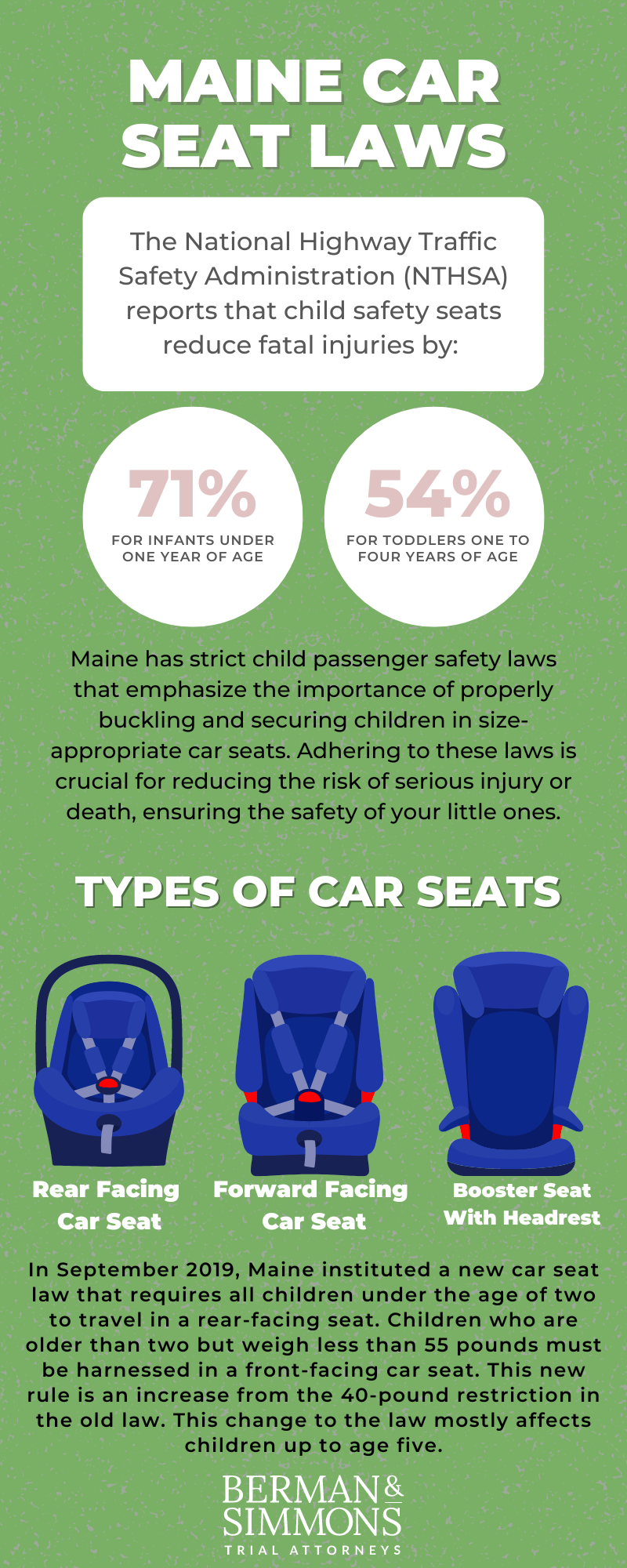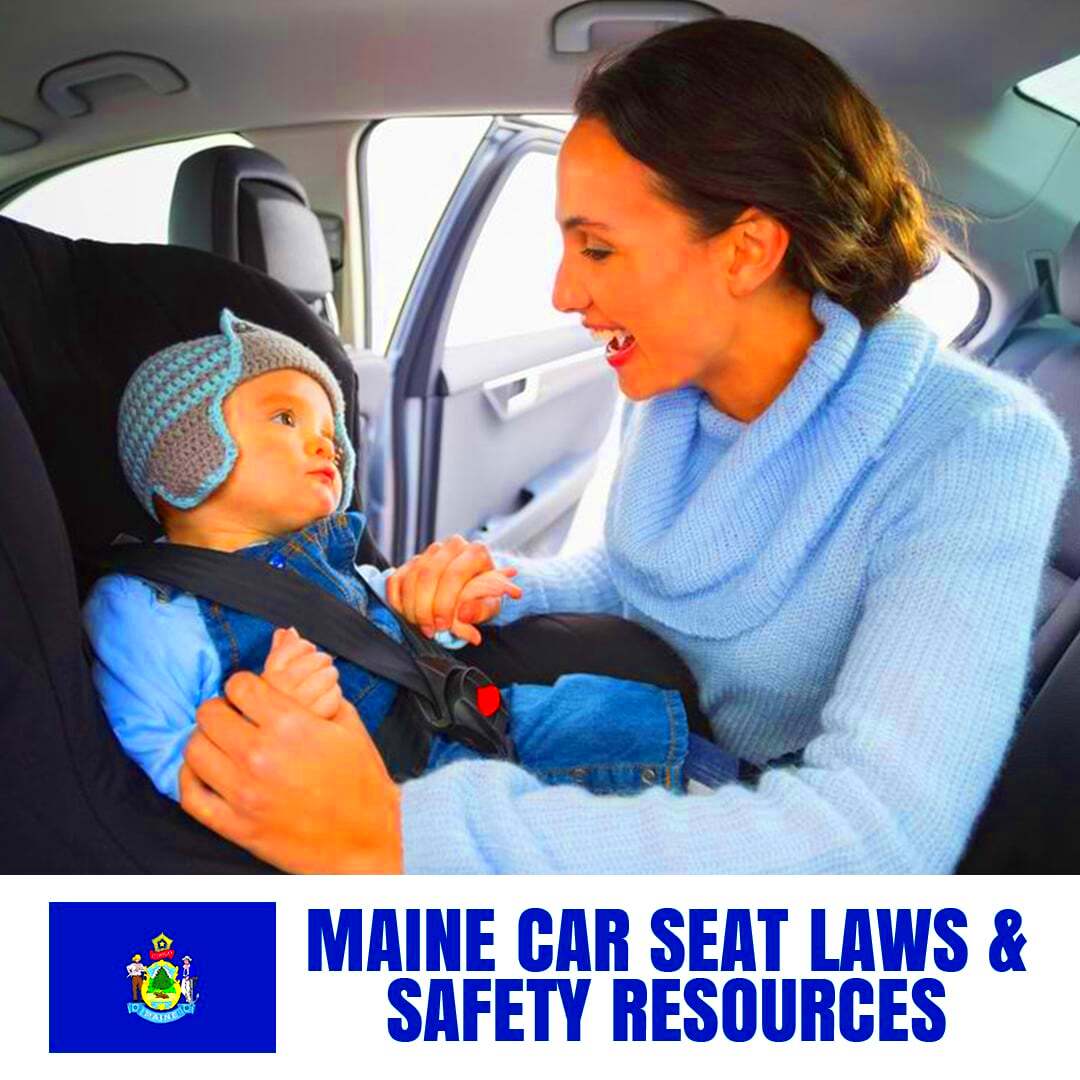Maine Car Seat Laws for 2023
Maine has specific car seat laws to ensure the safety of children while traveling. These laws are designed to protect young passengers and minimize the risk of injury in case of an accident. As a parent or caregiver, it’s essential to understand these laws and comply with them for your child’s safety. In this section, we’ll explore the key aspects of Maine’s car seat regulations, including the different types of car seats required and the age and weight requirements that dictate which car seat your child should use.
Types of Car Seats Required

In Maine, there are several types of car seats, each suitable for different age groups and sizes. Here’s a breakdown:
- Rear-Facing Car Seats: Recommended for infants and toddlers. They provide better support for the head, neck, and spine.
- Forward-Facing Car Seats: Suitable for children who have outgrown rear-facing seats. These seats are designed for older toddlers and young children.
- Booster Seats: Required for children who have outgrown forward-facing car seats. Booster seats help position the vehicle’s seat belt correctly.
- Seat Belts: Once children reach a certain age and size, they can transition to using seat belts without a booster.
It’s crucial to choose the right type of seat to ensure your child’s safety while riding in a vehicle.
Age and Weight Requirements for Car Seats

Maine’s car seat laws specify the following age and weight requirements:
| Age Group | Type of Car Seat | Weight Requirement |
|---|---|---|
| Birth to 2 years | Rear-Facing Car Seat | At least 20 lbs, but ideally until 2 years old |
| 2 to 4 years | Forward-Facing Car Seat | Minimum of 40 lbs |
| 4 to 8 years | Booster Seat | Must fit properly, usually over 40 lbs |
| 8 years and older | Seat Belt | Typically, at least 80 lbs and 4’9″ tall |
These requirements help ensure that children are securely strapped in and protected according to their size and developmental stage. Always refer to your car seat’s manual and your vehicle’s owner manual for the best guidance.
Proper Installation of Car Seats

Installing a car seat correctly is vital for keeping your child safe while traveling. Even the best car seat won’t protect your child if it’s not installed properly. In this section, we’ll guide you through the steps for installing a car seat, ensuring that you can travel with peace of mind. Remember, each car seat has its own set of instructions, so always refer to the manual. Here are some general tips:
- Read the Manuals: Review both the car seat manual and your vehicle’s owner manual to understand the specific requirements.
- Choose the Right Spot: The back seat is the safest place for a child. If possible, use the middle seat, as it is the furthest from any impact.
- Secure the Base: Use either the seat belt or the LATCH system. If using the seat belt, ensure it locks properly and is tightened securely.
- Check for Movement: After installation, give the car seat a firm shake. It should not move more than an inch side to side or front to back.
Taking the time to install your car seat correctly can make a significant difference in protecting your child. If you’re unsure, don’t hesitate to ask for assistance.
Common Mistakes to Avoid When Using Car Seats

Even with the best intentions, parents often make mistakes when using car seats. Here are some common pitfalls to watch out for:
- Not Using the Right Seat: Ensure you’re using the appropriate car seat based on your child’s age and weight.
- Incorrect Harness Tightness: The harness should be snug but not too tight. You should be able to fit only one finger between the harness and your child’s collarbone.
- Failing to Check Expiration Dates: Car seats have expiration dates. Using an expired car seat can put your child at risk.
- Not Registering the Car Seat: Register your car seat to receive recall information and safety updates.
By being aware of these common mistakes, you can help ensure that your child is as safe as possible while traveling.
Where to Get Help with Car Seat Safety
If you’re ever in doubt about car seat safety, plenty of resources can help you out. Here are some great places to start:
- Local Hospitals: Many hospitals offer car seat installation checks for new parents.
- Fire Departments: Some fire stations provide assistance in installing car seats and can help you ensure it’s secure.
- Certified Child Passenger Safety Technicians: Look for certified professionals who can guide you on proper car seat use and installation.
- Online Resources: Websites like the National Highway Traffic Safety Administration (NHTSA) offer helpful guides and videos.
Don’t hesitate to seek help. Your child’s safety is worth it, and there are many resources available to support you in making the right choices.
Penalties for Not Following Car Seat Laws
Following Maine’s car seat laws is not just about safety; it’s also the law. Failing to adhere to these regulations can result in penalties that can impact you financially and legally. Understanding these penalties is crucial for every parent or caregiver. Here’s what you need to know:
- Fines: If you are caught not using a proper car seat for your child, you may face fines. In Maine, fines can range from $50 to $500 depending on the violation.
- Points on Your License: In some cases, not adhering to car seat laws may result in points added to your driving record, which can lead to higher insurance premiums.
- Mandatory Education: Offenders may be required to attend a child passenger safety education course, adding time and expense to your schedule.
- Increased Liability: In the unfortunate event of an accident, not following car seat laws could increase your liability in a lawsuit.
It’s clear that following car seat laws is essential not just for your child’s safety but also for avoiding legal and financial repercussions. Always make sure your car seat meets Maine’s regulations to stay safe and compliant.
How Car Seat Laws Impact Parents and Caregivers
Car seat laws have a significant impact on parents and caregivers, shaping how they transport children. These laws aim to protect young passengers, but they also introduce responsibilities for adults. Here are a few ways these regulations affect you:
- Increased Awareness: Parents become more aware of the importance of car seat safety, prompting them to educate themselves and others.
- Financial Considerations: The requirement to purchase appropriate car seats can add to family expenses, especially when upgrading as children grow.
- Time Commitment: Understanding and installing car seats correctly requires time, often leading parents to seek professional assistance.
- Community Support: Awareness of car seat laws can lead to more community programs and resources for education and installation support.
While these laws can feel burdensome at times, they ultimately promote safer environments for our children, creating a culture of safety and awareness.
Frequently Asked Questions about Maine Car Seat Laws
Here are some common questions that parents often ask about Maine’s car seat laws:
- What is the fine for not using a car seat? Fines can range from $50 to $500, depending on the violation.
- Can my child use a seat belt instead of a booster seat? Children must use a booster seat until they are at least 8 years old or 4’9″ tall.
- Is it safe to buy a used car seat? You should be cautious with used car seats. Check for recalls, ensure it has not been in an accident, and verify the expiration date.
- How can I find help with car seat installation? Many local hospitals, fire departments, and certified technicians can assist with car seat installation.
These FAQs address some of the most pressing concerns about car seat laws in Maine. If you have further questions, don’t hesitate to reach out to local resources or consult professionals for guidance.
Conclusion on Car Seat Safety in Maine
Ensuring the safety of our children while traveling is a responsibility that every parent and caregiver takes seriously. Maine’s car seat laws are designed to protect young passengers and promote safe travel practices. By understanding the various types of car seats, adhering to age and weight requirements, and installing seats correctly, you can significantly reduce the risk of injury in case of an accident. Additionally, being aware of the penalties for not following these laws emphasizes the importance of compliance.
Ultimately, car seat safety is a collective effort that not only impacts individual families but also strengthens community awareness and support. As we continue to educate ourselves and others about these essential regulations, we contribute to a safer environment for all children. Remember, it’s never too late to seek help or information to ensure that you’re doing everything you can to keep your child safe on the road.


